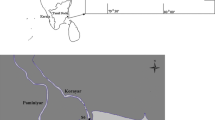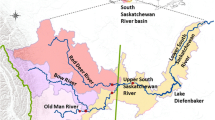Abstract
This work presents and recommends 1) an empirically based new model quantifying the relationship between salinity, suspended particulate matter (SPM) and water clarity (as given by the Secchi depth) and (2) an empirical model for oxygen saturation in the deep-water zone for coastal areas (O2Sat in %). This paper also discusses the many and important roles that SPM plays in aquatic ecosystems and presents comparisons between SPM concentrations in lakes, rivers and coastal areas. Such comparative studies are very informative but not so common. The empirical O2Sat model explains (statistically) 80% of the variability in mean O2Sat values among 23 Baltic coastal areas. The model is based on data on sedimentation of SPM, the percentage of ET areas (areas where erosion and transportation of fine sediments occur), the theoretical deep-water retention time and the mean coastal depth. These two new models have been incorporated into an existing dynamic model for SPM in coastal areas that quantifies all important fluxes of SPM into, within and from coastal areas, such as river inflow, primary production, resuspension, sedimentation, mixing, mineralisation and the SPM exchange between the given coastal area and the sea (or adjacent coastal areas). The modified dynamic SPM model with these two new sub-models has been validated (blind tested) with very good results; the model predictions for Secchi depth, O2Sat and sedimentation are within the uncertainty bands of the empirical data.













Similar content being viewed by others
References
Abdel-Moati MAR (1997) Industrial dumping impact on oxygen and nitrogen fluxes in Abu Qir Bay, southeastern Mediterranean Sea. Environ Int 23:349–357
Andreev A, Kusakabe M, Honda M, Murata A, Saito C (2002) Vertical fluxes of nutrients and carbon through the halocline in the western subarctic Gyre calculated by mass balance. Deep-Sea Res II 49:5577–5593
Blomqvist S (1992) Geochemistry of coastal Baltic sediments: processes and sampling procedures. PhD Thesis, Stockholm University, Sweden
Boulion VV (1994) Regularities of the primary production in limnetic ecosystems (in Russian). Nauka, St. Petersburg, 222 p
Boulion VV (1997) General characterization of some lakes in southern Karelia differing in the acidity and humic state. The response of lake ecosystems to changes in biotic and abiotic conditions (in Russian). St. Petersburg, pp 5–28
Brezonik PL (1978) Effect of organic colour and turbidity on Secchi disk transparency. J Fish Res Board Can 35:1410–1416
Carlson RE (1977) A trophic state index for lakes. Limnol Oceanogr 22:361–369
Carlson RE (1980) More complications in the chlorophyll—Secchi disk relationship. Limnol Oceanogr 25:379–382
Carlsson L, Persson J, Håkanson L (1999) A management model to predict seasonal variability in oxygen concentration and oxygen consumption in thermally stratified coastal waters. Ecol Model 119:117–134
De Schmedt F, Vuksanovic V, Van Meerbeeck S, Reyns D (1998) A time-dependent flow model for heavy metals in the Scheldt estuary. Hydrobiologia 366:143–155
Douglas RW, Rippey B, Gibson CE (2003) Estimation of the in-situ settling velocity of particles in lakes using a time series sediment trap. Freshw Biol 48:512–518
Foster IDL, Baban SMJ, Wade SD, Charlesworth S, Buckland PJ, Wagstaff K (1996) Sediment-associated phosphorus transport in the Warwickshire River Avon, UK. IAHS Publ (Proc Exeter Symp) 236:303–312
Foster IDL, Baban SMJ, Charlesworth SM, Jackson R, Wade S, Buckland PJ, Wagstaff K, Harrison S (1997) Nutrient concentrations and planktonic biomass (chlorophyll a) behaviour in the catchment of the river Avon. Warwickshire IAHS Publ (Proc Rabat Symp) 243:167–176
Foster IDL, Wade S, Sheasby J, Baban S, Charlesworth S, Jackson R, McIlroy D (1998) Eutrophication in controlled waters in Lower Severn Area. Final report, vols. 1 and 2. Environment Agency, Severn-Trent Region, Tewkesbury
Gray JR, Glysson GD, Turcios LM, Schwarz GE (2000) Comparability of suspended-sediment concentrations and total suspended solids data. Report 00-4191. U.S. Geological Survey, Reston, Virginia, 14 p
Håkanson L (1991) Physical geography of the Baltic. The Baltic Sea environment. Uppsala University, Uppsala
Håkanson L (1999) Water pollution—methods and criteria to rank, model and remediate chemical threats to aquatic ecosystems. Backhuys, Leiden, 299 p
Håkanson L (2000) Modelling radiocesium in lakes and coastal areas—new approaches for ecosystem modellers. A textbook with Internet support. Kluwer Academic, Dordrecht, p 215
Håkanson L (2005) Suspended particulate matter in lakes, rivers and coastal areas. Dept. of Earth Sciences, Uppsala University, 410 p
Håkanson L, Boulion V (2002) The lake foodweb—modelling predation and abiotic/biotic interactions. Backhuys, Leiden, 344 p
Håkanson L, Jansson M (1983) Principles of lake sedimentology. Springer, Berlin, p 316
Håkanson L, Peters RH (1995) Predictive limnology. Methods for predictive modelling. SPB Academic, Amsterdam, 464 p
Håkanson L, Kvarnäs H, Karlsson B (1986) Coastal morphometry as regulator of water exchange—a Swedish example. Estuarine Coastal Shelf Sci 23:1–15
Håkanson L, Gyllenhammar A, Brolin A (2004a) A dynamic model to predict sedimentation and suspended particulate matter in coastal areas. Ecol Model 175:353–384
Håkanson L, Blenckner T, Malmaeus JM (2004b) New, general methods to define the depth separating surface water from deep water, outflow and internal loading for mass-balance models for lakes. Ecol Model 175:339–352
Håkanson L, Mikrenska M, Petrov K, Foster IDL (2005) Suspended particulate matter (SPM) in rivers–empirical data and models. Ecol Model 183:251–267
Heiskanen A-S, Tallberg P (1999) Sedimentation and particulate nutrient dynamics along a coastal gradient from a fjord-like bay to the open sea. Hydrobiologia 393:127–140
Jørgensen SE, Johnsen J (1989) Principles of environmental science and technology, 2nd edn.. Elsevier, Amsterdam, 628 p
Kalff J (2002) Limnology. Prentice-Hall, Englewood Cliffs, NJ, 592 p
Kranck K (1973) Flocculation of suspended sediment in the sea. Nature 246:348–350
Kranck K (1979) Particle matter grain-size characteristics and flocculation in a partially mixed estuary. Sedimentology 28:107–114
Lick W, Lick J, Ziegler CK (1992) Flocculation and its effect on the vertical transport of fine-grained sediments. Hydrobiologia 235/236:1–16
Lindström M, Håkanson L, Abrahamsson O, Johansson H (1999) An empirical model for prediction of lake water suspended matter. Ecol Model 121:185–198
Matteucci G, Frascari F (1997) Fluxes of suspended materials in the north Adriatic Sea (Po prodelta area). Water Air Soil Pollut 99:557–572
OECD (1982) Eutrophication of waters. Monitoring, assessment and control. OECD, Paris, 154 p
Ostapenia AP (1987) Ratio between particulate and dissolved organic matter in waters of different types. Production-hydrobiological investigations of water ecosystems (in Russian). Leningrad, pp 109–115
Ostapenia AP (1989) Seston and detritus as structural and functional components of water ecosystems (in Russian). PhD Thesis, Kiev
Ostapenia AP, Pavljutin AP, Zhukova TV (1985) Conditions and factors determining quality of waters and trophic status of lakes (in Russian). Ecol Syst Naroch Lakes, Minsk, pp 263–269
Pearson TH, Rosenberg R (1976) A comparative study on the effects on the marine environment of wastes from cellulose industries in Scotland and Sweden. Ambio 5:77–79
Persson J, Håkanson L, Pilesjö P (1994) Prediction of surface water turnover time in coastal waters using digital bathymetric information. Environmetrics 5:433–449
Pilesjö P, Persson J, Håkanson L (1991) Digital bathymetric information for calculations of morphometrical parameters and surface water retention time for coastal areas (in Swedish). Report no. 3916. National Swedish Environmental Protection Agency (SNV), Solna, Sweden
Preisendorfer RW (1986) Secchi disk science: visual optics of natural waters. Limnol Oceanogr 31:909–926
Remane A (1934) Die Brackwasserfauna. Verh Dt Zool Ges 36:34–74
Velimorov B (1991) Detritus and the concept of non-predatory loss. Arch Hydrobiol 121:1–20
Voipio A (ed) (1981) The Baltic Sea. Elsevier Oceanographic Series, Amsterdam, 418 p
Vollenweider RA (1958) Sichttiefe und Produktion. Verh Int Ver Limnol 13:142–143
Vollenweider RA (1960) Beitrage zür Kenntnis optischer Eigenschaften der Gewässer und Primärproduktion. Mem Ist Ital Idrobiol 12:201–244
Vollenweider RA (1968) The scientific basis of lake eutrophication, with particular reference to phosphorus and nitrogen as eutrophication factors. Technical report DAS/DSI/68.27. OECD, Paris, 159 p
Wallin M, Håkanson L, Persson J (1992) Load models for nutrients in coastal areas, especially from fish farms (in Swedish with English summary). Nordiska ministerrådet 1992:502
Wetzel RG (2001) Limnology. Academic, London, 1006 p
Wulff F, Rahm L, Larsson P (eds) (2001) A systems analysis of the Baltic Sea. Ecological Studies, vol. 148. Springer, Berlin Heidelberg New York, 455 p
Acknowledgements
This work has been carried out within the framework of an INTAS project (no. 03-51-6541) coordinated by Dr. Richard B. Kemp, University of Wales, and the author would like to acknowledge the financial support from INTAS. I would also like to thank two anonymous reviewers for very constructive comments and suggestions.
Author information
Authors and Affiliations
Corresponding author
About this article
Cite this article
Håkanson, L. The relationship between salinity, suspended particulate matter and water clarity in aquatic systems. Ecol Res 21, 75–90 (2006). https://doi.org/10.1007/s11284-005-0098-x
Received:
Accepted:
Published:
Issue Date:
DOI: https://doi.org/10.1007/s11284-005-0098-x




